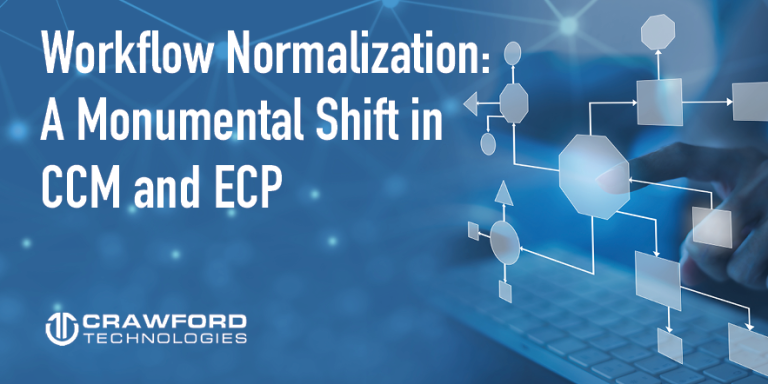RESOURCES
BLOG
Join in the community forum! The thINK blog is a place for community members to share their opinions, best practices, successes, and challenges. Add your comments to the blogs published here or write a blog and we’ll post it for you.

Workflow Normalization: A Monumental Shift in CCM and ECP
From thINK Ahead 2024 Partner Crawford Technologies
Workflow normalization, a term akin to the long-established practice of data normalization in database management, is emerging as a revolutionary approach to handling high-volume transactional communications within enterprises. Traditionally, such communications involve diverse data streams encompassing formats like PDF, AFP, PS, PCL and legacy Xerox data files. The inherent challenge lies in the unique nature of each piece of communication—think marketing collateral, compliance mailings, letters or bills—each with its distinct layout, pages and information.
While this diversity has historically posed challenges for legacy systems, modern intelligent workflow strategies pivot toward identifying commonalities among documents. Regardless of their specific content, every document shares fundamental attributes, such as paper size, address, account or recipient identification numbers, and various audit identifiers like barcodes or IMBs.
While the term "workflow normalization" has gained traction among industry experts, it's noteworthy that some may refer to it as workflow standardization, communication normalization or production data normalization. Regardless of the nomenclature, the essence remains the same: streamlining production printing and mailing workflows.
The crux of normalization lies in transcending the mere format of data streams and physical content locations. By conducting an initial identification pass and embedding essential information into data streams, workflows can be streamlined into a singular highway capable of processing any document or communication—whether it be a letter, marketing piece or compliance notice. The adoption of a unified, automated production workflow interconnected with printing and post-production equipment not only eliminates errors and bottlenecks, but also establishes a transparent auditing flow, enabling every stakeholder to track the status of production jobs or individual communications (mail pieces) seamlessly.
Various workflow steps, including barcoding, postal processing, de-duplication and segmentation, are seamlessly enabled based on the specific job or document, offering unparalleled flexibility and governance.
In today's landscape, merely generating a print job and stuffing pages into an envelope no longer suffices. The onus now lies on guaranteeing the accuracy and deliverability of addresses, especially considering the steep cost of mailing. A single letter can easily tally up to $1 after factoring in postage, printing, insertion and labor costs. Sending out communications that may go unread or, worse, directing crucial information to the wrong recipient is simply not an option. Many mailings are of a confidential nature, mandating meticulous auditing at every juncture of the process. Upholding 100% accountability for both data and content throughout the entirety of the mailing workflow is non-negotiable.
Integration and connectivity are paramount in modern workflow ecosystems. While connections to folders, mail inserters and print equipment form the backbone, integration with preference and consent management systems is often overlooked, yet critical for comprehensive mail verification.
Recently, I had the privilege of attending a presentation by Cheryl Kahanec, CEO of Quantum Group in Chicago, who aptly likened workflow normalization to a high-speed freeway with data files utilizing on- and off-ramps for processes such as warehouse stock availability or mail processing. Cheryl's endorsement underscores the transformative potential of workflow normalization, emphasizing the pitfalls of maintaining custom-made programs that risk organizational reputation due to their complexity and maintenance challenges.
While some may draw parallels between workflow normalization and capabilities offered by formats like AFPDS, it's essential to recognize that many organizations lacked a comprehensive global dictionary or standardized fields across jobs and applications, rendering AFP challenging for ensuring fully compliant, portable data. Moreover, with the global migration toward PDF as the "true" portable document format, the limitations of legacy formats become more apparent.
While it is easy to dump on legacy print formats, there are many faults with most of the PDF files created today, in even the best composition software. A well-configured normalization process can resolve those issues and add the intelligence into the print file that is needed to achieve the benefits of a normalized workflow discussed here.
Modern technology extends beyond the confines of AFP or PDF, enabling processing of diverse document formats within a unified workflow. The benefits are manifold:
- Simplified job status identification
- Intelligent processing, allowing print files to set up printers and inserters automatically
- Reduced errors and improved accuracy
- Elimination of reliance on tribal knowledge for job and application handling
- Enhanced piece-level and job-level auditing capabilities
- Better integration with inventory and postal processing
- Reduction of workflow by hundreds or thousands
- Better job status verification and visual reporting, in many cases
- Provides a robust standard flow for all applications
As technology progresses, setting up applications becomes increasingly streamlined, rapid and demands fewer technical personnel. Leveraging advancements such as artificial intelligence (AI) and low-code technology, a mailing application can now be seamlessly onboarded with all requisite configuration files. These files are pivotal in transforming your conventional data file, print job or mailing into an intelligent data file, primed for processing on the superhighway of what we term a "normalized workflow."
In a business environment that continually evolves where accuracy, efficiency and compliance are paramount, the need for streamlined workflows has never been more crucial. This means expertise in workflow normalization is imperative to empower organizations as they navigate the complexities of high-volume communications with confidence and agility. Crawford Technologies is a Canon partner with expertise in harnessing the power of workflow normalization for enterprise communications processing.
A digital document industry pioneer, Ernie Crawford is President/CEO and founder of Crawford Technologies. One of only a small number of people worldwide with M-EDP (Master Electronic Document Professional) designation, Ernie has more than 30 years of senior marketing and management experience in the high-volume digital printing market.
